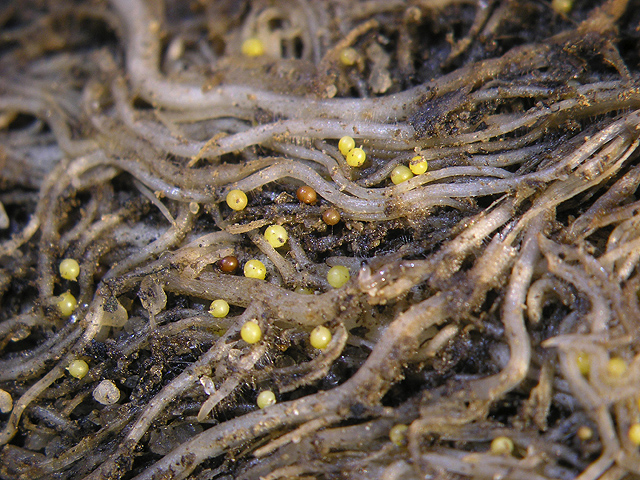Blog, oca (Oxalis tuberosa), pests
Oca: Is potato cyst nematode a concern?
I’ve had a few inquiries lately about potato cyst nematode infestation of oca (Oxalis tuberosa) and any time I see a question more than once, I start thinking about a blog post. I should emphasize from the beginning that I have no direct experience with this subject. As far as I know, there aren’t any potato cyst nematodes in my area to experiment with. In fact, probably no one who grows oca in North America will ever see a PCN, because it isn’t a common pest here. Why worry about it then? Oca was named as a possible host of potato cyst nematode and has made it onto the inspection lists of some state departments of agriculture as a result.

The potato cyst nematodes are a pair of species in the genus Globodera that live among the roots of mostly solanaceous plants, from which they feed, reducing yields and potentially allowing diseases to gain a foothold. They are common in the Andes and a few varieties are widespread in Europe, but they are rare elsewhere in the world due to agricultural inspection and quarantine. Potato cyst nematodes have popped up in a couple places in North America (Idaho and Quebec) where extreme measures have been taken to stamp them out.
So, is oca a host for potato cyst nematode? The answer appears to be “no,” although there are bulletins from many agriculture departments and universities that name oca as a potential host. In almost every case, these bulletins only cite other bulletins that don’t list a primary source themselves. Follow the chain back to the beginning and you will come to a paper titled “Nonsolanaceous Hosts of Globodera in the Andes” from 1979. That sounds promising.
This paper appears to be the origin (or at least the published origin) of the idea that PCN infests oca. In fact, the paper never says that. What it says seems to better support the opposite idea: “Diaz and co-workers (2) suspected that Oxalis tuberosa ([Gray] Heller), Ullucus tuberosus (Caldas.), and Chenopodium quinoa (Wild.) were hosts of the potato cyst nematodes. Martin et al. (5) observed
white female nematodes, which they called “white cysts,” on the roots of Oxalis tuberosa and Tropaeolum tuberosum (Ruiz
and Pav.) (two tuber-bearing food crops in the Andes) and on Medicago species in the province of Canta, Department of Lima,
and the Department of Cajamarca (central and northern highlands of Peru). Franco (unpublished) tested those species in a
greenhouse with a population of G. pallida from Tarma in the central highland and found that no cyst nematodes developed on nonsolanaceous Hosts of Globodera: Jatala et al. 211 their roots. Therefore, he concluded that an unrecognized mixture of segments of
potato roots with roots of Oxalis, etc., might account for the observation by Martin et al.” [2]
Jatala et al. go on to state that they found nematodes on the roots of oca, mashua, and ulluco in field collections, but that these nematodes had “some morphological differences,” [2] compared to PCN. Certainly, it pays to be cautious, but this is hardly a clear identification of PCN infestation of oca. Nevertheless, it was apparently enough to include oca on many lists of PCN hosts, probably out of an abundance of caution and possibly because those bulletins cited each other rather than the primary source.
Having tracked this story back to its beginning, the next step is to ask if there is more recent information available. And there is. In fact, Franco et al. evaluated 303 accessions of oca for their potential as a trap crop for PCN. It turns out that many oca varieties will stimulate egg hatch of PCN, but then fail to sustain them, dramatically reducing the dormant population. [1] This may reveal the wisdom of rotating between potato and oca in traditional agriculture in the Andes. (Similar results were found with ulluco and mashua as well.)
Improved information has not escaped the notice of regulators in the USA; it appears that it is just slow to percolate through the layers of published bulletins that contain the old information. A 2007 review by the USDA removes oca from the list of PCN hosts and actually spends a great deal of time discussing oca. They summarize as follows: “The results of this study indicated that oca is not a host of the potato cyst nematodes. Oca plants collected from fields infested with potato cyst nematodes showed no evidence of infection by either of the two pests.” [3] They include an updated list of potato cyst nematode hosts that does not include oca.
The evidence seems pretty clear that oca is not a host plant for potato cyst nematodes and, to the contrary, may actually be useful in combatting the spread of PCN. Generally, we’ve found that state agricultural inspectors have little interest in oca, but packages are occasionally held for inspection. Pointing inspectors to Sullivan et al. (linked below) might help to speed things along if they are working with outdated information.
References
1. Franco, J., G. Main, and R. Oros. 1999. Trap Crops as a Component for the Integrated Management of Globodera spp. (Potato Cyst Nematodes) in Bolivia: http://journals.fcla.edu/nematropica/article/view/64232/61900
2. Jatala, P., J. Franco, A. Vilca, and W. Cornejo. 1979. Nonsolanaceous hosts of Globodera in the Andes: http://www.ncbi.nlm.nih.gov/pmc/articles/PMC2617943/pdf/210.pdf
3. Sullivan, M.J., R.N. Inserra, J. Franco, I. Moreno-Leheude, and N. Greco. 2007. Potato Cyst Nematodes: Plant Host Status and Their Regulatory Impact: http://journals.fcla.edu/nematropica/article/download/64425/62093

